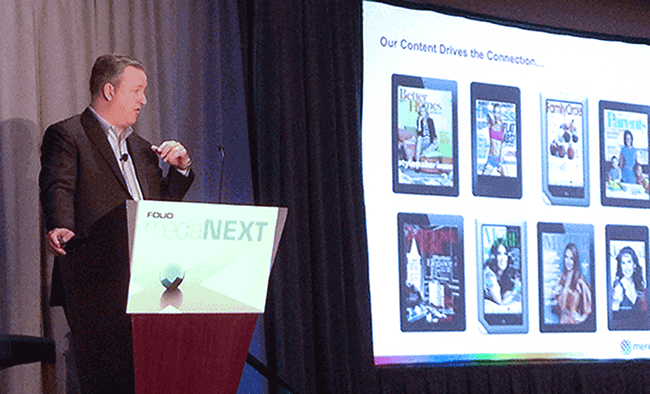Connecting with Consumers in Digital Times
How does a magazine publishing company survive and thrive in the digital age? By changing with the times without betraying its core mission. On the one hand the company must engineer editorial to meet the requirements of delivery channels such as social media and mobile apps, molding its product to conform to and exploit the limitations and potentialities of tablets and cell phones. On the other hand the publisher must maintain and exceed a level of editorial integrity and service that over the years have built core audience loyalty.
Known for its century-old titles such as Better Homes and Gardens and Ladies Home Journal, Meredith has been engaging in a modern day balancing act, reengineering content for the digital age while maintaining firm control over reader-focused editorial.
“For our company to keep growing we must keep thinking about how our magazine brands can connect with consumers in new ways,” said Tom Harty, President of the company’s National Media Group. Speaking at a Folio Magazine conference earlier this year, Harty illustrated the importance of digital delivery with an arresting fact: “65 percent of magazine lovers aged 18 to 34 follow a magazine editor or columnist on Twitter.”
Responding to consumer demand for multi channel delivery, the Better Homes and Gardens brand has expanded from its print origins into tablet, web sites, and mobile apps. The response has been enthusiastic, said Harty. “Technology has changed the conversation we have with consumers. Readers can now interact with our brands how and when they want to. Today almost half our connection with readers is through some sort of digital channel.”
Mobile rules
For many people, the word “digital” conjures up images of web sites. But in many cases the fastest growing digital channel is mobile, a term which embraces tablet and smart phone access. Consider the after effects of Meredith’s acquisition of allrecipes.com a year ago, a move which doubled the company’s digital footprint in Meredith’s number one content area: food. “At the time we acquired allrecipes.com 15 percent of the site’s traffic was mobile,” said Harty. “Today, after a period of less than 12 months, mobile represents 50 percent of the site’s access. And half of that traffic is happening inside a store. This is a tremendous change.”
The consumer’s embrace of mobile explains why the company’s motto is now “change plus innovation equals sustained growth,” said Harty. “Change is an opportunity to grow our brands.”
Even so, change for its own sake can backfire. Indeed, the company must not get ahead of its audience. “We know that only two to three percent of our women have switched to the tablet format,” said Harty. “We realized that simply being the first to market was not critical at this stage of the technology. It was more important to focus on delivering the content in the most appropriate format for our audiences.”
If the tablet transformation is gradual, it is sure. “We are working hard to bring our brands into the tablet era. We are true believers.”
King Content
In this royal court of publishing the Crown may be digital but the King is content. “We are not a technology products company,” Harty emphasized. “We are a content company. The curated and trusted content of our magazines and our digital media drive our connection with our core audience of 100 million women. At the end of the day we have to deliver on our brand promise.” The “crux” of Meredith’s strategy to fulfill that promise is the provision of content aligned with what Harty describes as the “three main focuses” of the company’s readers: family, home and well being.
Indeed, the house of Meredith is built upon a foundation of magazines in their ideal form of molded content. “I have to remind everyone at Meredith and in the industry how many people still love magazines,” said Harty. He offered supporting MPA numbers: “Magazines are witnessing unprecedented strong growth among consumer audiences. Print magazines are read by nine out of 10 adults and 95 percent of adults 18 to 24.”
That loyalty translates into dollars. “Consumers spend more than $300 million a month to buy magazines at the news stand,” said Harty. “And the number of brands advertising in magazines has increased 57 percent in last two years.”
Meredith’s own numbers reflect a continuing interest in magazines. “Our total magazine audience is 116 million,” said Harty. “Never before in our history have our magazines reached such a large audience. During the worst economic recession in two generations our subscription business has never been better. We are constantly reinvesting in our magazines and brands to make sure we are best in class.”
Editorial Dialog
At one level, the modern multi-channel approach has fundamentally changed Meredith’s dynamic with advertisers. Today a single sponsor might purchase a package that communicates a message through several related magazines in a number of print and digital channels. The result is a more powerful and compelling offer. “It’s not about selling ad pages anymore,” said Harty. “It’s not about selling digital banner ads. It’s about selling client solutions across many platforms.”
Equally compelling is the transformation in editorial. Mature and seasoned as it is, content continues to evolve in subtle ways as readers exploit technology to gain an interactive presence. “In today’s media world people view your brands more as a daily content experience,” said Harty. Escalating patterns of reader interactivity offer opportunities for a closer engagement of editorial with consumer needs.
Harty offered one example. “We recently reinvented the Ladies Home Journal brand, fueled by social media. The traditional way LHJ was created was that editors would sit around a table, decide what they thought was important to their readers, and create content. Hopefully readers would read something that they found interesting.”
The new editorial model allows readers to involve themselves with the content in a much more intimate way. “Social media sites are leveraged to start the conversation with readers before we actually create the magazine content,” said Harty. “These conversations fuel the brand with what really matters to its readers and help develop the original content. The editorial teams use this fuel along with their trusted expertise and external advisors and internal experts to expand ideas and fill LHJ with socially fueled vibrant content.”
The initiative has succeeded. “Over the past nine months the model has been unbelievably responded to,” said Harty. “The result has been the transformation of one of our oldest brands. We knew it would be a challenge but we also knew this brand has always been driven by highly engaged conversations with readers.”
As Meredith applies this methodology to other magazine properties it is illustrating a bright path for publishing houses to flourish in the digital age. In the process the company has transformed itself, in Harty’s words, “from a traditional print publishing company into a national marketing communications organization.”
Article and photo: Phillip M. Perry


